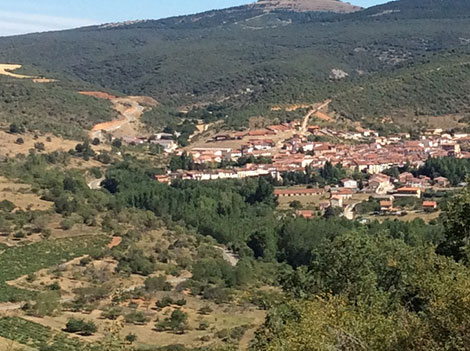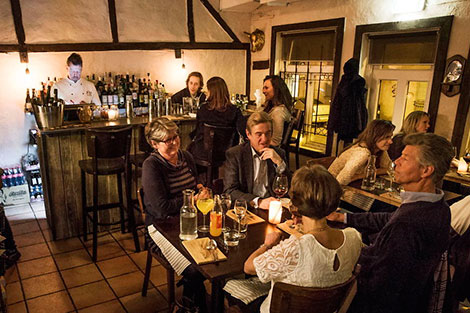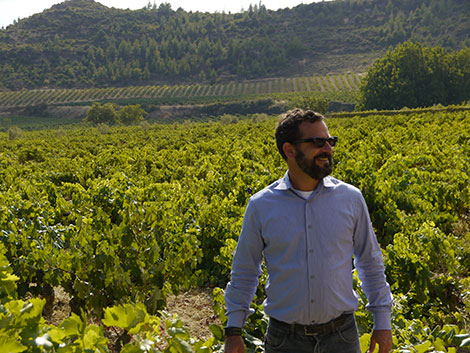
Frenchman Olivier Rivière is making a name for himself in Rioja where he has recently managed to get hold of some vines. Back in 2008 it seemed almost impossible to become a vineyard owner in Spain’s most famous wine region, so when fellow winemaker Bertrand Sourdais (former winemaker at Ribera del Duero’s Dominio de Atauta, now running his own venture in the area) told him about the much more affordable plots in Covarrubias, south of Burgos (Castilla y León), Olivier decided to explore the region.
Despite initial difficulties to find the vineyards and after asking the elders in the village, he was taken to El Quemado, a high altitude, sun-drenched area with clay soils and plenty of old vines. Wines here have a lot of everything, says Olivier: “depth, breadth, alcohol, acidity and tannins”. No wonder he is particularly fond of this place —it is the first vineyard he bought in Spain and by the following vintage (2009) he was already making wines.
A unique microclimate within DO Arlanza
Covarruvias is nestled in the easternmost valley within the DO Arlanza in the province of Burgos. The appellation stretches west along the river bearing the same name until its confluence with the river Pisuerga in the province of Palencia. With DO status since 2007, surface under vine stands at around 400 hectares (55 of them in Covarrubias) and annual wine production totals around 1.2 million litres. Tempranillo is the dominant grape variety so the style has unsurprisingly followed Ribera del Duero’s model, its celebrated neighbour. Nevertheless, Arlanza’s northern latitude contributes to lighter palates with wines showing more acidity and noticeable, sometimes even harsh, tannins.
Covarrubias has a different character though. This is the highest area in the appellation with vines grown at over 1,000 metres of altitude. Old vines are intermixed with fruit trees and grow on terraces and slopes creating a captivating landscape. The Mamblas mountain range, which protects the valley from the northern winds and late frosts, helps to build a unique microclimate that enables such a range of crops. Harvest usually begins in the second week of October.
“Climate change helps to ripe grapes at such altitude”, says winemaker David González. Along with friends Juan Antonio, Bécquer and Luis, they have created Sabinares, a painstaking project to which they dedicate most of their spare time.
David, who together with Juan Antonio Leza is behind the rebirth of historic producer Gómez Cruzado in Haro’s Barrio de la Estación in Rioja, was born in nearby Villalmanzo, while Valladolid-based wine distributor Luis Martín is from Lerma, the main town in the Arlanza appellation. Bécquer Prieto, the only one in the group born in Covarrubias, works as a winemaker in Ribera del Duero and is happy to recover the wine growing tradition his family forwent long ago. The winery name is a tribute to the area’s stunning landscape, particularly the Arlanza juniper (sabinar in Spanish) woodlands, the most extensive of its kind in Europe boasting over 2,000 year-old trees. The first Sabinares wines were released on the 2011 vintage.
A bit of Castilian history
Despite its major role in Castilian history, Covarrubias hasn’t been home to any famous wines. An enclave within the route followed by legendary hero El Cid Campeador after his exile from Burgos in 1081, the village enjoyed glorious times under count García Fernández in the 10th century (it boasts the only Castilian fortress of that period) and during the 15th and 16th centuries when the ancient collegiate church was built.
As it was the case in Ribera del Duero and particularly in Peñafiel, clarete (a rosé fermented with skins in the style of a red) was the most common wine. Know as churrillo, it was destined for local consumption and to meet the high demand from Burgos and the towns in the surrounding mountainous area. Grapes usually fermented in communally-owned lagares and wine was kept in large chestnut barrels. More recently, locals placed a cloth on their home door to signal that (bulk) wine was for sale.
Rural exodus hasn’t helped wine making. Vines have lost ground in favor of fruit trees although it seems that both have co-existed for a long time —they are intermixed in old vineyards where other varieties can be found alongside Tempranillo, locally called picadillo. Red grapes such as Mazuelo, Garnacha, Mencía or Trousseau and whites Albillo Real and Viura (both of them authorized by Arlanza’s Regulatory Board) but also Malvasía Riojana or Palomino, explains David González.
Covarrubias’ terroirs and wines
Despite the relatively small size of the valley, vine growing areas are perfectly defined in Covarrubias.
Limestone soils with red clay locally called tierra de riñón are dominant on the left bank of the river Arlanza. Here lies El Quemado, a small plateau reaching over 1,000 metres of altitude and considered the grand cru in the valley; La Tizona, named after a local mountain; and further west El Caballo, a small and airy valley with vines grown on slopes. The right bank shows distinctive alluvial and stony soils both in Valdable, the traditional, terraced wine growing area stretching from the road to the river and further east at the higher Amesado area, at 950 metres of altitude.
Olivier Rivière owns three plots at El Quemado —hardly one hectare—, but only one is used for his top red bearing the same name (€44,75 at Vinissimus, 900 to 1,000 bottles). For their part, Sabinares grows one and a half hectares in the area, distributed in six plots with the best grapes selected for their top of the range wine El Confín (only 600 bottles produced, €46.90 via Wine Searcher).
El Cadastro (€24.95 at Vila Viniteca or via Wine Searcher) is Olivier’s village wine. It’s a blend of the floral, lighter grapes from La Tizona which he always destems; the remaining crop from El Quemado intended to build the wine’s skeleton (usually with some stems in fermentation) and the “ripe, round, deep” character sourced from Amesado. Aged in 300- and 500-litre barrels, it displays a clean character with ripe, sun-drenched fruit.
“Covarrubias wines are rather bipolar” says Olivier Rivière. “This is a cool, extreme area, but the sun can really beat down. I used to extract more in the past; now I work in a gentler way, with longer aging times”. He has recently released a third red called La Vallada (€11.5 at Vila Viniteca). It comes from 15 year-old vineyards owned by local wine growers and its retail price is more affordable compared with other wines coming from very old vines and made in tiny quantities.
Sabinares’ second red for instance retails at over €25. El Temido (3,715 bottles the 2012 vintage, €28.40 at Lavinia or via Wine Searcher) includes around 30% of wine aged in cement egg-shaped vats, the rest being oak-aged. Unlike Rivière, all bunches are destemmed at Sabinares.
White wines are almost insignificant. Olivier has only produced his Albillo Real Basquevanas —which also includes some Albillo Mayor, Viura and Palomino— in 2009 and 2010 (this vintage can be bought at Barcelona Vinos for €49.34). Wine making is extremely laborious since he has to pick grapes separately from white vines scattered among reds in his various vineyards; all of them together fill just one barrel. The rich, honeyed and aniseed flavoured Sabinares Blanco de Guarda 2012 (600 bottles, €24.65 at Gourmet Hunters or via Wine Searcher) is a mix of different white grapes which are picked all together, when the dominant Albillo variety shows perfect ripeness.
Other wines from DO Arlanza
In the second half of October, the Arlanza appellation celebrated its first professional tasting in Madrid. Unfortunately, neither Olivier Rivière nor Sabinares or other producers from Covarrubias were present. Compared to the satisfying ripe fruit I had found in this distinctive village, many of the red wines I tasted in Madrid were less full on the palate with noticeable, sometimes even harsh tannins. There was also the influence of the “Roble” category from Ribera del Duero which resulted in intrusive amounts of oak.
In my opinion, the most outstanding wines were from Buezo (all of them from the 2005 vintage so tannins were well tamed), Bodega La Colegiada (benefiting from winemaker Óscar Navarro’s experience at Arzuaga-Navarro in Ribera with richer, softer palates) and the small venture led by winemaker Soraya Angulo, who has returned to her small home town of Castrillo de Solarana, very close to Lerma, where she is determined to make quality wines from local, ancient vineyards. For the time being, she produces just 5,000 bottles divided in three different wines with retail pricees ranging from €11 to €20.
The singularity of Covarrubias does not lie on easy-to-find, affordable wines; it’s about recovering vineyards and plots that would otherwise disappear because the next generation is not taking care of them. When I first visited the Arlanza appellation in the early 2000s I was struck by Covarrubias’ distinctive, isolated landscape, but was disappointed not to find a single wine that matched this singularity. Now there are a few thousand bottles on the market showing the DNA of this unique terroir. Let’s hope others join in the future.

Amaya Cervera
A wine journalist with almost 30 years' experience, she is the founder of the award-winning Spanish Wine Lover website. In 2023, she won the National Gastronomy Award for Gastronomic Communication
US importers who champion Spanish wines
NEWSLETTER
Join our community of Spanish wine lovers






